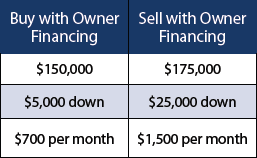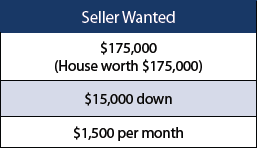Prescreening Prospects
Posted on November 26, 2013 byIn our last issue, I dealt with Locating Prospects by using a virtual assistant to call FSBO ads. I said that’s pretty much all we do here and can’t keep up with the leads they generate. This month we’ll discuss how to determine if it’s a suspect or a prospect and quickly determine which need to be called and which need to be trashed.
It all begins with my Property Information Sheet. It’s also located in my courses. This form is the heart of the pretty house business. It’s as important to an investor as food is to a restaurant. (Nope, I couldn’t write this without a restaurant reference.)
There are several things you must know before you can prescreen a prospect. Until you get these facts, you can’t tell if it’s a deal or a dud. Many try and wonder why they are confused. You’ll always be confused without the critical facts.
Here are the critical facts:
- What is the asking price?*
- What does the seller think its worth?*
- What’s it really worth?*
- What’s owed on it?*
- What’s the payment, is it current and if not, how far behind?*
- When does the seller want to move?*
Note all these questions have a star beside them on the Property Information Sheet for a reason.
YOU’RE DEAD IN THE WATER UNTIL YOU GET THE ANSWERS.
Fortunately, all but one are simply questions you or your VA ask the seller. The “your comps” line is where you go to sites like Zillow.com and see what you think the house is worth by looking at comparable sales, comps.
Of course, I’d want the rest of the blanks filled in, but the stars are the critical questions that will lead me to the deal breaker questions in the script in the center of the page. The real separator between deal and dud are the “yes” or “no” questions in the middle.
YES means Deal
NO means Dud
The goal is to get a few yeses every week, which lead to a few calls you make and one or two appointments to get a contract signed by the seller.
So, let’s look at the script. On the left it says, “Will you sell for what you owe?” If the answer is “yes,” you can either take over the existing debt with no money if the seller is willing, and most are, or you can lease option it for the loan balance with no money. It’s usually your choice. Which you do is a discussion for Quick Start Real Estate School, not a newsletter.
Note, it says only ask this question if the loan balance and asking aren’t too far apart. It’d be foolish to ask if they are and will probably kill your relationship with the seller before it even gets started.
If the ARV (After Repaired Value) is $200,000, the loan is $120,000 and the seller is asking $190,000, would you really ask if they’d sell for what they owe? NO!
The center section asks if they’d consider a lease purchase if the house has a mortgage. Sixty-six percent do! Thirty-four percent are free and clear!
Sometimes the house is over-leveraged, which is easy to see if the loan is more than the value. When you get a “yes” to the lease option question here, and most will be, you have a potential ACTS deal. Your goal is to lease option it for the loan balance for ten years and then assign your lease to a tenant buyer and collect $5,000 to $25,000 assignment fee.
See my Control Without Ownership course and Quick Start Real Estate School for complete training on ACTS (Assigning Contracts and Terms System).
All you need to see if it’s a prospect is does the seller agree to lease option, is the payment reasonable and is it in a good area and decent condition? All of these questions are on the form.
If you get a “yes” here and there’s some equity, you may want to do a sandwich lease and stay in the deal. You lease option from seller and sublease it to buyer at higher price and payment. You collect rent, pay the seller and keep the difference.
The simple math tells you if it’s an ACTS or sandwich lease option. The seller’s “yes” answer tells you it’s a prospect. A call to them confirms it.
On the right side, you’ll see an owner finance question for free and clear houses. If you get a “yes” to the first question, you have a seller willing to take monthly payments. Our goal here is two-fold. One, see if we can create a killer deal with sweet terms we can stay in and make a lot of money for years to come. That will occur when the seller will take little or no down payment and a low monthly payment.
We can then buy it and resell with owner financing or lease purchase it to collect a big down payment from the buyer and a big monthly spread.
Example:

That’s $20,000 easy profit and $800 a month income for years with a quick in and out with no costly entanglements. These are my favorite deals. One a month could quickly put you out of a job.
FYI, if you’re worried about the $5,000 down, don’t. You close the purchase and the sale on the same day so the buyers’ $25,000 covers the $5,000.
Sometimes, the seller will owner finance, but wants retail price, a higher payment than you want to make and a down payment so large, you wouldn’t write the check.
Example:

You wouldn’t close on this yourself in the past because it’s at retail price and there’s no monthly spread. Well, you won’t close on it now either, but you can ACTS it. Simply put it under contract for what the seller asks with the understanding you’ll find a buyer the seller approves and keep what you get above the $15,000.
That means the buyer will pay the $175,000 at $1,500 a month and the $15,000 down plus your $10,000 assignment fee, and you’re out.
If you’re wondering, if any sellers say “yes,” to owner financing, the answer is absolutely!
Remember, even sellers with free and clear houses have trouble selling for all cash. They have the same issues to overcome as any house with a mortgage. What’s owed doesn’t matter to a conventional buyer getting a new loan.
Some sellers will gladly take payments to move the house for numerous reasons. You only need a few yeses a month to build a substantial cash flow.
So, here we are, looking at our property information sheets and scanning for yeses. They all are free and clear or have a mortgage. They are in good condition or not and current or in arrears.
As long as you can see how to profit prescreening has become easy using my sheet. The sellers prescreen themselves with “yes” or “no” answers. Once you’ve called the “yeses,” I’d call the “nos.” Some turn into “yeses.” If you call them and still get a “no,” the best place for the sheet is in a trash can. It’s worthless to you. You can’t make unmotivated sellers motivated.
You can’t make chicken salad out of chicken crap!
Deal with those who want to deal with you, and whack the rest at lightning speed. If you get 10–15 leads a week, you should get 2–5 “yeses.” If not, it’s likely your VA needs more work or you need more training.
If you need a VA, call 800-567-6128 to get more information. Global Publishing will find and train one for you, pay them and replace if needed. Don’t hire a VA to call FSBOs until you’ve been trained on how to follow-up with the leads.
There are four steps to learning:
1. Ignorance
2. Awareness
3. Implementation
4. Automation
Once you pass the first one, we can take you the rest of the way. Fortunately, implementation and automation will be done simultaneously with the help of VAs.
Man, you guys got it easy today! I used to actually work at this business. Most of the work has been removed today.
Hey, if you intend to get to my Quick Start Real Estate School while I still teach it, you’d better make a move. I’m 66 years old. How long do you think this body can handle it?
Next article is on constructing and presenting the offer!
